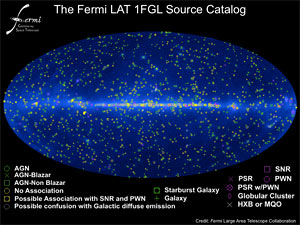
Handy Links
SLAC News Center
SLAC Today
- Subscribe
- Archives: Feb 2006-May 20, 2011
- Archives: May 23, 2011 and later
- Submit Feedback or Story Ideas
- About SLAC Today
SLAC News
Lab News
- Interactions
- Lightsources.org
- ILC NewsLine
- Int'l Science Grid This Week
- Fermilab Today
- Berkeley Lab News
- @brookhaven TODAY
- DOE Pulse
- CERN Courier
- DESY inForm
- US / LHC
SLAC Links
- Emergency
- Safety
- Policy Repository
- Site Entry Form

- Site Maps
- M & O Review
- Computing Status & Calendar
- SLAC Colloquium
- SLACspeak
- SLACspace
- SLAC Logo
- Café Menu
- Flea Market
- Web E-mail
- Marguerite Shuttle
- Discount Commuter Passes
-
Award Reporting Form
- SPIRES
- SciDoc
- Activity Groups
- Library
Stanford
Around the Bay
Fermi Telescope Releases First Source Catalog
The first catalog of high-energy gamma-ray sources detected by the Large Area Telescope on the Fermi Gamma-ray Space Telescope was published online Tuesday, expanding upon the Bright Source List, an early release of the first 200 detected sources published in July 2009.
The Fermi-LAT catalog is the culmination of 11 months of data collection and includes 1451 sources in 10 different classes, providing numerous opportunities for new avenues of research that will help explain some of the most powerful forces shaping our universe. The paper will appear in the June issue of The Astrophysical Journal Supplement Series, where it was posted online May 25.
"For most of the sources we don't know exactly what they are," said Seth Digel, a physicist at SLAC National Accelerator Laboratory and a corresponding author of the paper. The researchers have categorized 630 sources as "unassociated." Hundreds more are associated with a particular type of gamma-ray source based on their location or other properties, but more data is needed to determine their exact nature. Only a handful of the sources are actually identified, with most being pulsars—rotating, magnetized neutron stars that emit broad beams of gamma rays.
In fact, before the mission, Digel said, the only identified gamma-ray emitters were pulsars and blazars, which are a type of active galaxy that also emits intense jets of radiation. The rest of the classes, including supernova remnants, globular clusters and starburst galaxies, have been confirmed as new types of gamma-ray sources as a result of the mission. "Finding a new class of sources is more interesting for some people than finding just another pulsar or blazar," Digel said.
However, the LAT was particularly successful in finding millisecond pulsars, as well as detecting gamma-ray sources with pulsar-like properties that have since been found to be pulsars in deep follow-up observations with large radio telescopes.
In developing the catalog, the LAT Collaboration studied objects in the 100 MeV to 100 GeV energy range, dividing it into five bands, and measured the average amount of energy in each of the bands for a given area of the sky over the 11-month period. Detected objects were given a firm identification when they demonstrated characteristics such as periodic emissions or variability matching an object at another wavelength; associations were made based on qualities including location and spectral information.
With the release of the catalog, LAT collaborators and guest investigators can take advantage of the in-depth data on each source and continue to make identifications. They can study the unassociated sources as populations with similar properties or individually, and attempt to connect them to objects in other astronomical catalogs.
Researchers might also probe whether any of the unidentified sources could be dark matter. This invisible substance accounts for most of the mass in the universe and is thought to exist in clumps. In particularly clumpy areas, dark matter particle pairs would frequently meet and, in some models, annihilate one another, accounting for steady sources of high-energy gamma rays.
Raw data from the LAT is received at SLAC and processed into useful information for the investigators-mostly by filtering out the noise caused by cosmic rays, Digel said.
The international LAT Collaboration will release a second catalog after two years of data collection and a final catalog after five years. Since the LAT's ability to spot gamma-ray sources increases with time—much as a camera with a longer exposure time will capture more light—the group is hoping to find up to 2500 sources by the two-year mark.
"This is kind of a small number and a big number," Digel said. While other databases contain hundreds of millions of objects, being able to identify just a few thousand gamma-ray sources can be tricky. Analysts won't be able to average the data over the entire collection period as they did for the first catalog, because some objects, such as blazars, are variable enough that they would be missed. Instead, the researchers must decide how to subdivide the data set so that they are still able to distinguish individual sources.
Although the team has made only a few confident identifications so far, Digel is encouraged by the results. "We know much, much more about these unknown sources than in previous missions," he said.
—Lauren Rugani
SLAC Today, May 28, 2010
